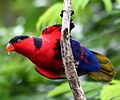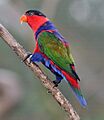Black-capped lory facts for kids
Quick facts for kids Black-capped lory |
|
|---|---|
 |
|
| At Jurong BirdPark, Singapore | |
| Conservation status | |
| Scientific classification | |
| Synonyms | |
|
Psittacus lory Linnaeus, 1758 |
The black-capped lory (Lorius lory) is a super colorful parrot that lives in New Guinea and some nearby islands. It's also known as the western black-capped lory or the tricolored lory because of its many colors! This lory is about 31 centimeters (about 12 inches) long. It has bright green wings, a red head, a black cap, and blue legs and belly. Most black-capped lories also have a blue area on their neck and back. Even though it's still common, one type, called cyanuchen, is quite rare, with fewer than 5,000 left.
Contents
About the Black-capped Lory's Name
The black-capped lory got its official name from a Swedish scientist named Carl Linnaeus in 1758. He wrote about it in his book Systema Naturae. Linnaeus learned about this bird from an English naturalist named George Edwards. Edwards had described and drawn the lory in his own book in 1751.
The word lory comes from the Malay word for these bright parrots. Today, the black-capped lory is part of a group of parrots called Lorius. This group was first named by an Irish zoologist, Nicholas Aylward Vigors, in 1825.
Different Kinds of Black-capped Lories
There are seven different kinds, or subspecies, of the black-capped lory. They all look a bit different in their colors:
- L. l. lory: Found on islands near New Guinea. It has lots of purple-blue on its body.
- L. l. erythrothorax: Lives along the south coast of New Guinea. It has a blue neck and blue on its belly.
- L. l. somu: Found in the southern hills of central New Guinea. This one has a red neck and back.
- L. l. salvadorii: Lives on the northwest coast of Papua New Guinea. It's similar to erythrothorax but has blue-black under its wings.
- L. l. viridicrissalis: Found on the northeast coast of Western New Guinea. It's like salvadorii but with darker blue.
- L. l. jobiensis: Lives on Yapen and Mios Num islands. It's like salvadorii but has lighter colors on its chest and back.
- L. l. cyanuchen: Found on Biak island. This type has a black cap that connects to the blue on its neck.
How Black-capped Lories Live
Black-capped lories live in thick forests and along the edges of forests. They usually stay in low areas, up to about 1,000 meters (or 3,280 feet) high. You won't find them in dry monsoon forests or coconut farms.
These birds are often seen in pairs. Sometimes, you might spot them in small groups of 10 or more. They love to eat pollen, nectar (the sweet liquid from flowers), flowers, fruits, and even small insects.
Gallery









